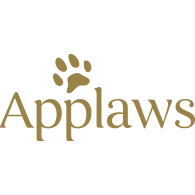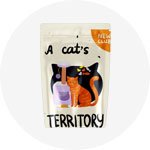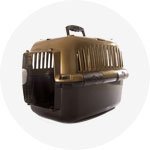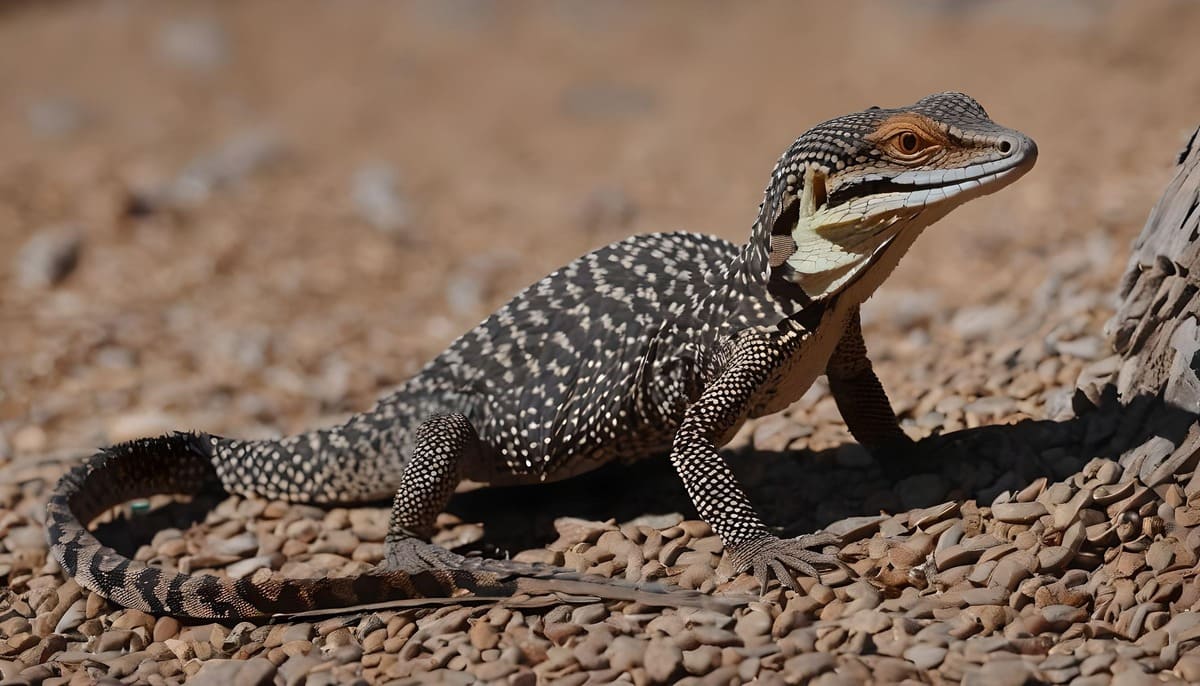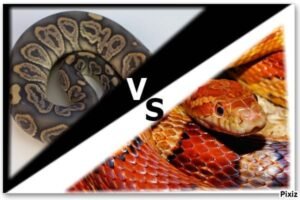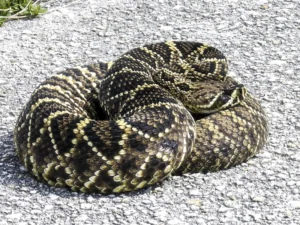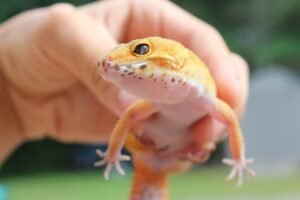Ackie Monitor | Overview, 15 Facts, Conservation, History, Behaviour
Explore the complete guide to Ackie Monitor care! Whether you’re a reptile expert or new to these fascinating creatures, this post covers everything from their physical traits to ideal habitats and diets. Discover essential tips for creating a perfect enclosure, ensuring a balanced diet, and fostering a healthy relationship with your Ackie Monitor. Let’s dive into the secrets of optimal care for a happy and thriving scaly friend!
Ackie Monitor
The Ackie Monitor, scientifically referred to as Varanus acanthurus, is a captivating lizard species native to the arid regions of northern Australia. Renowned for its distinctive appearance and manageable size, the Ackie Monitor has become a popular choice among reptile enthusiasts seeking a unique and rewarding companion.
One of the most noticeable features of Ackie Monitors is their relatively compact size, typically ranging from 2 to 3 feet. This makes them more manageable compared to larger monitor species. Their robust build and striking coloration, which can include deep reds, oranges, and earthy tones, contribute to their appeal. In their natural habitat, these monitors blend seamlessly into rocky outcrops, crevices, and hollow logs.
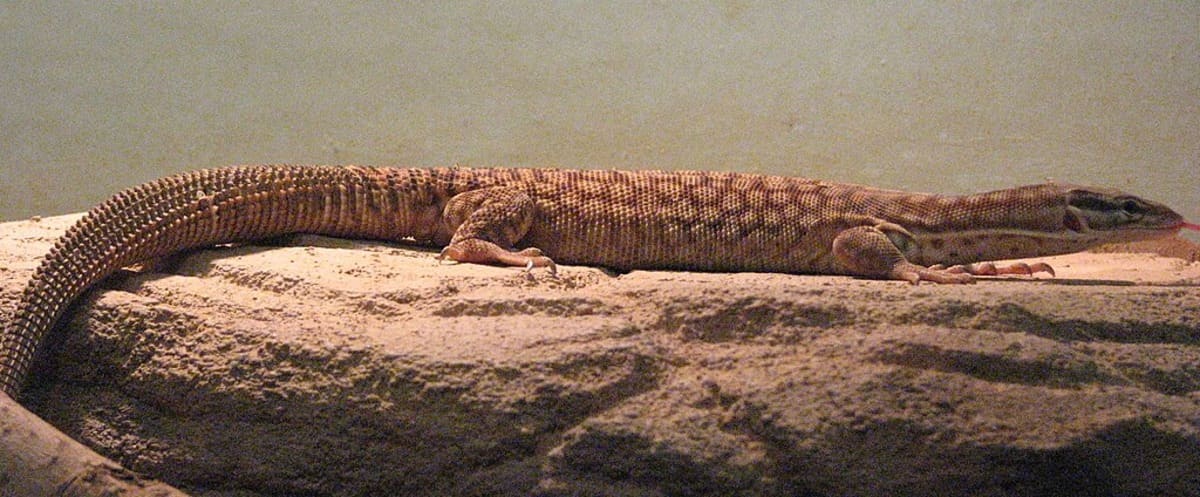
Endemic to Australia, Ackie Monitors thrive in the arid landscapes of the northern territories. Their natural habitat provides rocky shelters for thermal regulation, and these monitors are well-adapted to basking in the sun or retreating into hiding spots when necessary.
Despite being part of the monitor lizard family, Ackies are known for their relatively docile nature, making them more approachable for reptile enthusiasts. While individual personalities can vary, many Ackies can become quite tame with regular and gentle handling. Their inquisitive behavior is evident as they explore their surroundings, climb, and engage in natural behaviors.
In terms of diet, Ackie Monitors are opportunistic feeders in the wild, consuming insects, small vertebrates, and bird eggs. In captivity, a balanced diet includes a variety of insects, such as crickets, mealworms, and roaches, along with appropriate vegetables and fruits. Adequate calcium supplementation is crucial for their bone health.
Creating a suitable enclosure is vital for the well-being of Ackie Monitors in captivity. A spacious setup with hiding spots, climbing structures, and a basking area is essential. Maintaining proper temperature gradients and providing UVB lighting contribute to their overall health. Ackie Monitors, known for their intelligence, benefit from an enriching environment that promotes both physical and mental stimulation.
Characteristics and Overview of Ackie Monitor
Here are some common Characteristics and Overview of Ackie Monitor:
| Characteristic | Overview |
|---|---|
| Scientific Name | Varanus acanthurus |
| Size | Typically 2 to 3 feet, with a robust build |
| Coloration | Striking colors, including deep reds, oranges, and earthy tones |
| Habitat | Native to arid regions of northern Australia, thrives in rocky outcrops, crevices, and hollow logs |
| Behavior and Temperament | Relatively docile, can become tame with gentle handling, known for inquisitive behavior and exploration |
| Diet | Opportunistic feeder in the wild, consumes insects, small vertebrates, and bird eggs |
| Enclosure Needs | Requires a spacious enclosure with hiding spots, climbing structures, and a basking area |
| Environmental Adaptations | Well-adapted to basking in the sun and retreating into hiding spots for thermal regulation |
| Intelligence | Displays intelligence, benefits from an enriching environment for physical and mental stimulation |
| Captive Diet | Varied diet of insects (crickets, mealworms, roaches) and supplemented with appropriate vegetables |
| Health Considerations | Requires proper temperature gradients, UVB lighting, and calcium supplementation for bone health |
Colour Variations in Ackie Monitors
There are mainly three types of Colour Variations in Ackie Monitors, that are:
Red Ackie Monitor
When it comes to the Red Ackie Monitor (Varanus acanthurus acanthurus), enthusiasts are drawn to its stunning and vibrant color palette. Originating from the central and western regions of Australia, these monitors showcase an array of red and orange hues. Their coloration, characterized by its intensity, adds a captivating dimension to the species. The Red Ackie’s vibrant appearance, combined with its manageable size, makes it a popular choice among reptile enthusiasts.

Yellow Ackie Monitor
The Yellow Ackie Monitor (Varanus acanthurus brachyurus) is known for its distinct coloration and hails from the northern and northeastern parts of Australia, including Queensland. Displaying shades of yellow and orange, these monitors exhibit a more subdued yet equally attractive appearance. The Yellow Ackie’s unique color variation, coupled with its docile nature, makes it a sought-after species for those looking to welcome a captivating reptilian companion into their homes.
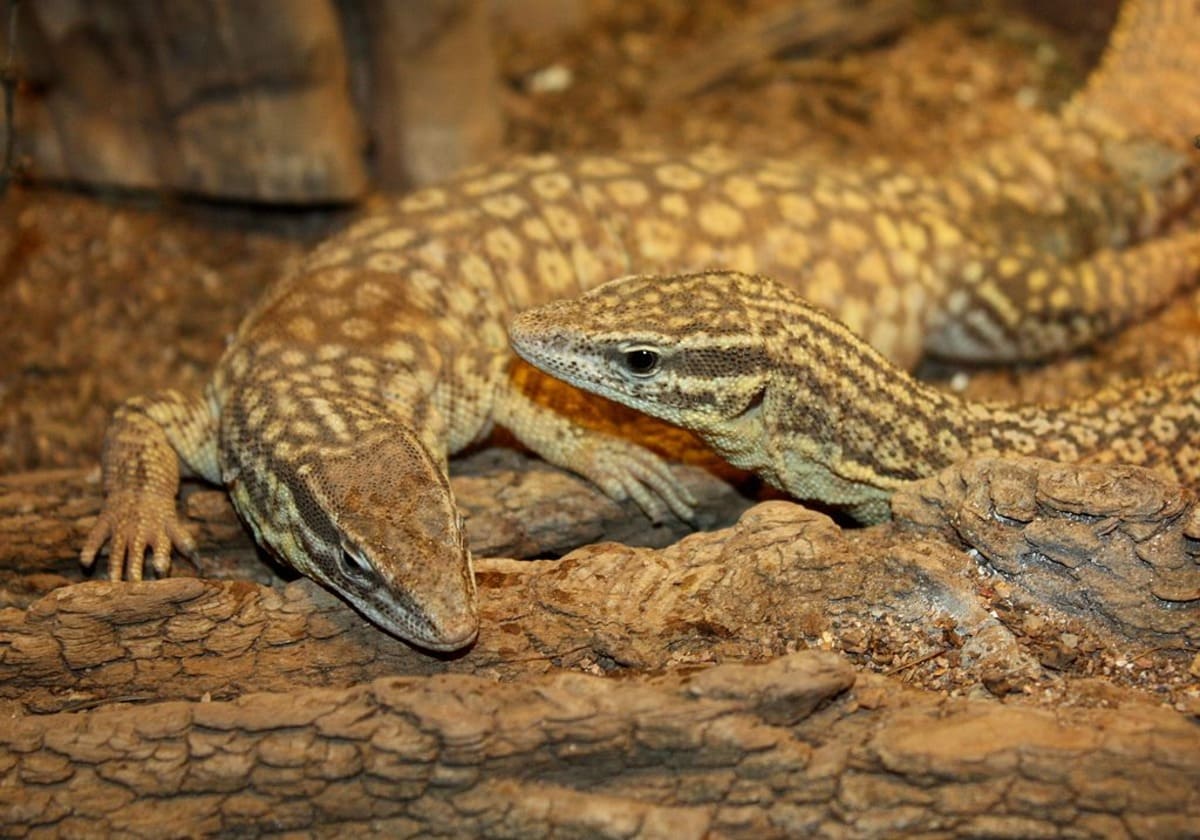
Blue Ackie Monitor
While the term “Blue Ackie Monitor” is not associated with a specific subspecies, some individuals may exhibit a bluish tint in certain lighting conditions. This subtle color variation adds an intriguing aspect to the Ackie-Monitor spectrum. It’s important to note that the “blue” appearance is often a result of iridescence rather than a solid blue color. As with all Ackie-Monitors, proper care, including a well-structured habitat and a balanced diet, contributes to their overall health and the potential expression of these subtle color variations.
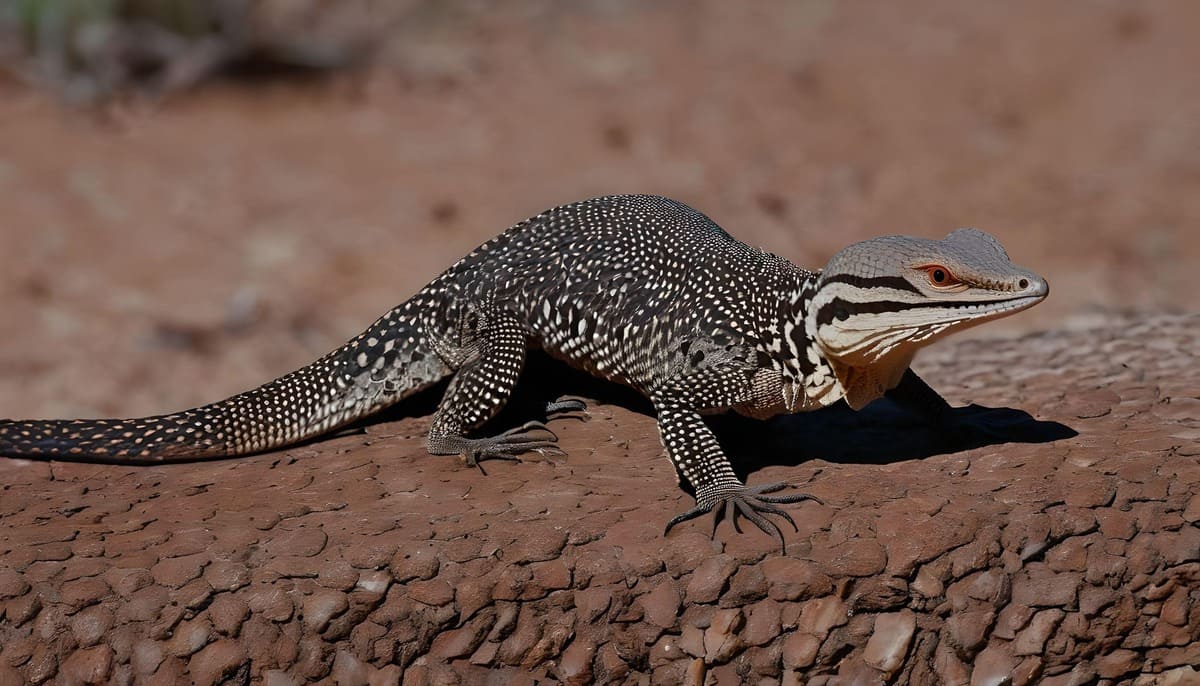
Ackie Monitor Geographic Range
The Ackie Monitor, scientifically known as Varanus acanthurus, is indigenous to the arid regions of northern Australia. Its geographic range spans across central, western, and northeastern parts of the country. Ackie-Monitors are adapted to thrive in the harsh, rocky landscapes of their native habitat, where they can be found in crevices, rocky outcrops, and hollow logs. Understanding their natural geographic range is crucial for creating a captive environment that mirrors their arid origins.
Origin, Evolution and History of Ackie Monitor
The origin, evolution, and history of the Ackie Monitor are deeply rooted in the arid landscapes of Australia. As a species, Ackie-Monitors have evolved to adapt to the challenges of their environment, showcasing features and behaviors that have allowed them to survive and thrive. Their history is intertwined with the unique ecosystems of northern Australia, and gaining insights into their evolutionary journey adds a layer of appreciation for these fascinating reptiles.
Anatomy of Ackie Monitors
The anatomy of Ackie Monitors is a testament to their adaptability. These monitors have a robust build, featuring strong limbs and claws suitable for climbing and digging. Their scales provide protection, and their sharp senses contribute to their survival in the wild. Understanding the anatomy of Ackie Monitors is essential for providing optimal care in captivity, ensuring their physical well-being is supported.
Appearance of Ackie Monitors
The appearance of Ackie Monitors is marked by their manageable size, vibrant color variations, and distinctive patterns. Ranging from 2 to 3 feet in length, Ackies exhibit hues of red, orange, and earthy tones. Their captivating appearance, coupled with an inquisitive gaze, makes them a visually appealing choice for reptile enthusiasts.
Temperament of Ackie Monitor
In terms of temperament, Ackie Monitors are known for their relatively docile nature. With proper handling and care, these reptiles can become quite tame. Individual personalities may vary, but many Ackies exhibit a curious and friendly demeanor. Building a positive relationship with an Ackie-Monitor involves patience and gentle interactions.
Behavior and Lifestyle of Ackie Monitor
Ackie Monitors display intriguing behaviors in both the wild and captivity. Their inquisitive nature leads them to explore their surroundings actively. Climbing, digging, and basking are common behaviors that reflect their natural instincts. Ackie-Monitors are diurnal, meaning they are active during the day, and providing an enriching environment encourages their natural behaviors.
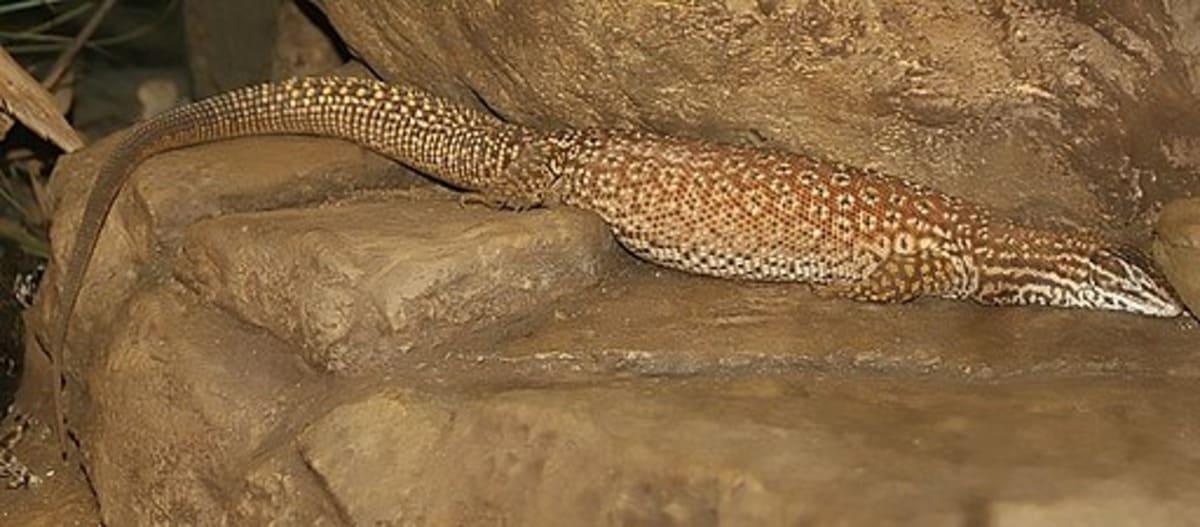
Habitat and Distribution
The habitat and distribution of Ackie Monitors are closely tied to the arid regions of northern Australia. These monitors favor rocky environments, utilizing crevices and hollow logs for shelter and thermal regulation. Understanding their habitat preferences is crucial for creating a captive environment that promotes their well-being.
Social Structure
Ackie Monitors are generally solitary creatures, and their social structure in the wild is characterized by individualistic behavior. While they may encounter each other in their native habitats, particularly during breeding seasons, they do not exhibit complex social structures. In captivity, it is advisable to house Ackie-Monitors separately to prevent territorial disputes.
Ackie Monitors Traits
Ackie Monitors possess a unique set of traits that contribute to their charm and adaptability. Their manageable size, vibrant coloration, and inquisitive nature make them popular among reptile enthusiasts. Ackies are known for their relative docility, allowing for positive interactions with their human caretakers. These traits, combined with their intelligence and engaging behaviors, make Ackie Lizard a fascinating and rewarding species to observe and care for.
Distribution and Habitat of Ackie Monitor
The distribution of Ackie Monitors is primarily concentrated in the arid regions of northern Australia. Their habitat preference includes rocky outcrops, crevices, and hollow logs, providing them with shelter and thermal regulation. Understanding their distribution and habitat requirements is crucial for both their conservation in the wild and their well-being in captivity.
Reproduction and Life Cycles of Ackie Monitor
Ackie Monitors undergo a fascinating reproductive process. Mating typically occurs during the breeding season, with females laying eggs in concealed nests. The life cycle involves the hatching of eggs, followed by the development of juvenile monitors. Observing and understanding the reproductive and life cycle behaviors of Ackie Lizard contributes to effective breeding programs in captivity.
Communication, Vocalizations and Perception of Ackie Monitor
While not known for elaborate vocalizations, Ackie Monitors communicate through body language, postures, and scent marking. Their acute senses, including keen eyesight and olfactory perception, play a vital role in their interactions with conspecifics and the environment. Deciphering these communication cues enhances our understanding of their social dynamics.
Predators and Threats of Ackie Monitor
In their natural habitat, Ackie Monitors face threats from predators such as birds of prey and larger reptiles. Human-related factors, including habitat destruction and collection for the pet trade, pose additional threats. Acknowledging these threats is crucial for implementing conservation measures that safeguard the species and their ecosystems.
Ackie Monitor Ecological Niche
The ecological niche of Ackie Monitors is vital to maintaining ecosystem balance. As diurnal hunters, they control insect and small vertebrate populations, contributing to the regulation of prey species. Ackie Lizard play a unique role in their ecosystem, and understanding their ecological niche aids in preserving biodiversity.
Impact on Local Ecosystems
While Ackie Monitors contribute to ecological balance, their populations can be affected by environmental changes. Human activities, such as habitat alteration and introduction of invasive species, may impact Ackie Lizard populations. Studying their role in local ecosystems is crucial for implementing conservation strategies that ensure their long-term survival.
Relationship with Other Species
Ackie Monitors share their habitat with various species, and understanding their interactions with other fauna is essential. Coexistence with fellow reptiles, insects, and small mammals contributes to the intricate web of ecological relationships. Studying these relationships enhances our comprehension of the interconnectedness of species in their ecosystems.
Ackie Monitor Genome Sequencing and Conservation Genetics
Genome sequencing projects for Ackie Monitors offer valuable insights into their genetic makeup and potential adaptations. Conservation genetics focuses on preserving genetic diversity to ensure the species’ resilience in the face of environmental challenges. These initiatives are crucial for formulating effective conservation strategies and captive breeding programs.
Genome Sequencing Projects
Ongoing genome sequencing projects aim to unravel the genetic mysteries of Ackie Monitors. Analyzing their genome provides information about their evolutionary history, adaptations, and potential genetic diversity. Collaborative efforts in genome sequencing contribute to a comprehensive understanding of this species.
Conservation Genetics and Breeding Programs
Conservation genetics plays a pivotal role in ensuring the long-term survival of Ackie Monitors. Breeding programs in captivity focus on maintaining genetic diversity and preventing inbreeding. Conservation initiatives that integrate genetic research and responsible breeding practices are instrumental in safeguarding the species.
Ackie Monitor in Popular Culture and Mythology
Ackie Monitors have found a place in popular culture and mythology, often portrayed in various media forms. Their unique appearance and behaviors contribute to their symbolic significance in storytelling, folklore, and cultural representations. Acknowledging their presence in popular culture enhances public awareness and appreciation for these reptiles.
Cultural Significance
In certain cultures, Ackie Monitors may hold cultural significance or symbolic meaning. Understanding the cultural context and beliefs associated with these reptiles fosters a broader appreciation for their role in local traditions. Ackie Lizard may be revered or considered important figures in folklore, contributing to cultural biodiversity.
Ackie Monitor Tourism and Responsible Wildlife Watching
The allure of Ackie Monitors has led to wildlife tourism opportunities, allowing enthusiasts to observe these reptiles in their natural habitats. Responsible wildlife watching practices, such as maintaining a respectful distance and minimizing environmental impact, are essential for preserving the well-being of Ackie-Monitors and their ecosystems.
Balancing Tourism and Conservation
As Ackie Monitor tourism grows, striking a balance between visitor experiences and conservation efforts becomes crucial. Implementing sustainable tourism practices ensures that the presence of tourists does not negatively impact Ackie Monitor populations or their habitats. Collaboration between conservationists, tour operators, and local communities is vital for achieving this delicate balance.
Educational Initiatives for Tourists
Educational initiatives aimed at tourists can foster a deeper understanding of Ackie Monitors and their ecosystems. Providing information on their behavior, conservation status, and the importance of responsible tourism helps raise awareness. Tourists, equipped with knowledge, become advocates for the conservation of Ackie Monitors and their habitats.
Ackie Monitor Price
The price of Ackie Monitors can vary based on factors such as age, size, coloration, and the breeder or seller. Typically, the cost ranges from $150 to $500, with variations depending on the specific type or subspecies, such as Red Ackie or Yellow Ackie. It’s essential to consider the reputation of the breeder, the health and condition of the lizard, and any additional supplies included in the purchase.
Red Ackie Monitor For Sale
Finding a Red Ackie Monitor for sale requires careful consideration of reputable breeders or sellers. Prices for Red Ackie Lizard may be slightly higher due to their vibrant coloration and popularity. When purchasing a Red Ackie, it’s crucial to inquire about the lizard’s health, previous care, and ensure that the sale complies with legal regulations regarding exotic pet ownership.
Ackie Monitors For Sale
Various breeders and reptile enthusiasts offer Ackie Monitors for sale through online platforms, pet stores, or reptile expos. Prices and availability may fluctuate based on demand and the breeder’s reputation. Prospective buyers should thoroughly research the seller, inquire about the lizard’s health and history, and confirm that the transaction aligns with legal requirements and ethical breeding practices.
Factors that Affect the Price of Ackie Monitor
Several factors influence the price of Ackie Monitors, reflecting the diversity in their characteristics and the reptile market. Understanding these factors is crucial for both buyers and sellers to make informed decisions. Here are key elements that can affect the price of Ackie Monitors:
- Coloration and Morphs (Red Ackie vs. Yellow Ackie): The color variation between Red Ackie and Yellow Ackie-monitors can impact their price. Red Ackies, with their vibrant hues, may be priced higher due to their striking appearance.
- Age and Size (Juveniles vs. Adults): Younger Ackie Monitors are generally more affordable than adults. The size of the lizard also plays a role, with larger specimens often commanding higher prices.
- Genetics and Morphology: Certain genetic traits or morphological features, such as unique patterns or color variations, can influence the price. Monitors with rare or desirable genetic characteristics may be priced higher.
- Health and Condition: The overall health and condition of the Ackie Monitor are critical. Healthy, well-cared-for individuals from reputable breeders may be priced higher due to the assurance of a quality specimen.
- Source and Breeder Reputation: Ackie-Monitors from established and reputable breeders may have higher prices due to the breeder’s track record, adherence to ethical practices, and commitment to producing healthy specimens.
- Availability and Demand: The law of supply and demand plays a role in pricing. If Ackie Lizard are in high demand and low supply, prices may increase. Conversely, oversaturation in the market can lead to more competitive pricing.
- Geographic Location (Local vs. International): Prices may vary based on the geographic location of the buyer and seller. International transactions may involve additional costs such as shipping fees and import/export regulations.
- Included Accessories or Supplies: Some sellers may include a complete enclosure setup, including tanks, heating elements, and other accessories. The inclusion of these items can impact the overall price.
- Legal Compliance: Compliance with local and international laws and regulations regarding the trade and ownership of exotic reptiles can influence pricing. Ethical breeders adhere to legal requirements, which can add to the cost.
- Market Trends: Shifts in consumer preferences or trends within the reptile-keeping community can affect prices. Popular morphs or species may see fluctuations in pricing based on current trends.
Monthly Maintenance Cost of Ackie Monitors:
The monthly maintenance cost of Ackie Monitors can vary based on factors such as the size of the enclosure, the type and quantity of food provided, the need for specialized lighting and heating equipment, and potential veterinary expenses. Here’s a breakdown of potential monthly costs:
- Food: Ackie-Monitors have a varied diet that includes insects, such as crickets, roaches, and mealworms, as well as appropriate vegetables and fruits. The cost of food will depend on the type and quantity purchased. On average, this cost may range from $20 to $50 per month.
- Enclosure Maintenance: This includes substrate (bedding), cleaning supplies, and potential replacements or upgrades to the enclosure. The monthly cost for enclosure maintenance can vary but might range from $10 to $30.
- Electricity: Ackie Monitors require specific temperature and lighting conditions. The cost of electricity to power heating elements, UVB lighting, and other equipment may contribute to the monthly expenses. This cost can vary widely based on local utility rates and the efficiency of the equipment in use.
- Veterinary Care: While veterinary visits may not be a monthly occurrence, it’s essential to budget for potential health issues or routine check-ups. Costs for veterinary care can vary, and having an emergency fund for unforeseen medical expenses is advisable.
- Supplements: Ackie Monitors may require calcium and vitamin supplements to ensure proper nutrition. The cost of these supplements can be included in the monthly budget and might range from $5 to $15.
- Environmental Enrichment: Providing items for environmental enrichment, such as climbing structures, hiding spots, and other accessories, contributes to the well-being of Ackie Lizards. Depending on the items purchased, this cost may vary from $10 to $30 per month.
- Insurance: Some reptile owners opt for pet insurance to cover potential veterinary expenses. The monthly cost of insurance can vary based on the coverage selected.
- Miscellaneous: Miscellaneous expenses may include replacement bulbs for lighting, additional accessories, or unforeseen costs. Allocating a small amount for miscellaneous expenses, such as $10 to $20 per month, is prudent.
Facts about Ackie Monitor
Here are some interesting facts about Ackie Monitors:
- Scientific Name: The Ackie Monitor is scientifically known as Varanus acanthurus.
- Common Names: Ackie Lizard are also commonly referred to as Spiny-tailed Monitors, Ackies, or Ridge-tailed Monitors.
- Geographic Range: Native to the arid regions of northern Australia, Ackie Monitors are found in areas such as Queensland, the Northern Territory, and Western Australia.
- Size: Ackie Monitors are relatively small compared to some other monitor species, typically reaching lengths of 2 to 3 feet (60 to 90 cm).
- Distinctive Coloration: They come in various colorations, with the Red Ackie featuring vibrant reds and oranges, while the Yellow Ackie displays yellow and orange tones. Blue hues may also be observed in certain lighting conditions.
- Basking Behavior: Ackie Monitors are diurnal, meaning they are active during the day. They are known for their basking behavior, utilizing the sun to regulate their body temperature.
- Intelligence: Ackie Lizards are considered intelligent reptiles. They can learn to recognize their owners, and some individuals become quite tame with regular handling.
- Inquisitive Nature: Ackies are curious creatures, known for exploring their surroundings actively. They may climb, dig, and investigate objects in their environment.
- Diet: In the wild, Ackie-Monitors are opportunistic feeders. Their diet includes a variety of insects, small vertebrates, and even bird eggs. In captivity, they are commonly fed a diet of insects and supplemented with fruits and vegetables.
- Reproduction: Female Ackie Monitors lay clutches of eggs, typically in concealed nests. The eggs hatch after an incubation period, giving rise to juvenile monitors.
- Solitary Lifestyle: Ackie Monitors are generally solitary in nature. While they may encounter each other, especially during breeding seasons, they don’t exhibit complex social structures.
- Habitat Preferences: Their natural habitat consists of rocky outcrops, crevices, and hollow logs. Ackie Monitors are well-adapted to arid conditions and can thrive in a variety of terrains.
- Threats and Conservation: Habitat destruction, collection for the pet trade, and introduced predators are threats to Ackie-Monitor populations. Conservation efforts focus on sustainable practices, captive breeding, and habitat preservation.
- Legal Protections: Ackie Lizards are subject to legal protections in some regions to prevent over-collection from the wild. It’s essential for owners to be aware of and adhere to local and international regulations.
- Captivity Requirements: Successfully keeping Ackie Monitors in captivity requires a properly-sized enclosure with climbing structures, hiding spots, and appropriate heating and lighting. Providing a diverse and enriched environment is crucial for their well-being.
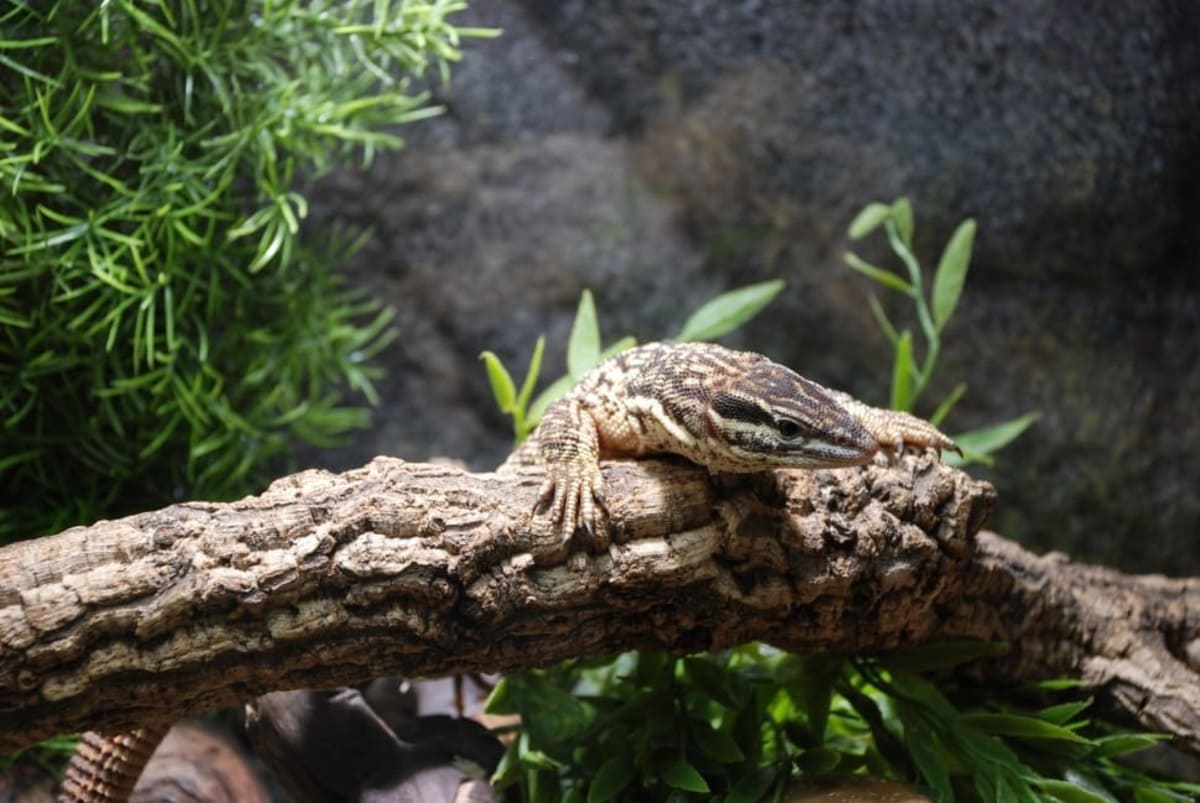
Pros and Cons of Ackie Monitor
Here are some common Pros and Cons of Ackie Monitor:
| Pros of Ackie-Monitors | Cons of Ackie-Monitors |
|---|---|
| Manageable Size: Ackies are smaller compared to many other monitor species, making them more suitable for captivity. | Specialized Care: Requires specific environmental conditions, including temperature and lighting. |
| Docile Nature: Relative docility makes them amenable to handling with proper care. | Potential Aggression: While generally docile, individual personalities may vary, and some may display aggression. |
| Intelligence: Ackie Lizards are considered intelligent, showing problem-solving skills. | Escape Artists: Known for their climbing ability, Ackies may attempt to escape if enclosures are not secure. |
| Diurnal Habits: Active during the day, allowing for more interaction with owners. | Space Requirements: Need a spacious enclosure with climbing opportunities, which may be challenging in limited spaces. |
| Fascinating Behaviors: Display natural behaviors like digging, climbing, and basking. | Long Lifespan: Long-term commitment; Ackies can live for more than 15 years. |
| Varied Diet: Can be fed a diet of diverse insects, providing an enriching feeding routine. | Initial Setup Costs: Setting up a proper enclosure can incur significant costs. |
| Hardy Species: When provided with proper care, Ackie Lizards are generally hardy. | Potential Zoonoses: Like all reptiles, Ackies can carry bacteria that may pose a risk to humans. |
| Individual Personalities: Ackies can develop individual bonds with their owners. | Limited Availability: Depending on location, finding Ackie Lizard for sale may be challenging. |
Ackie Monitor Care
Here are some common Care Tips for Ackie Monitors:
- Enclosure Setup: Provide a spacious, escape-proof enclosure with a mix of soil and coconut coir substrate.
- Temperature and Lighting: Maintain a basking spot at 120°F (49°C) with a gradient to cooler areas and provide UVB lighting.
- Humidity: Keep humidity between 60-70% using a moisture-retaining substrate and regular misting.
- Feeding: Offer a varied diet of insects, small rodents, and occasional eggs, dusted with calcium and vitamins.
- Hydration: Provide a shallow water dish for drinking and soaking, ensuring it’s not too deep.
- Enrichment and Hideouts: Furnish the enclosure with hiding spots, branches, and climbing structures for mental stimulation.
- Handling: Minimize handling to reduce stress, handling gently and supporting the body when necessary.
- Health Monitoring: Regularly observe for signs of illness and schedule veterinary check-ups for overall health.
- Cleaning and Maintenance: Spot clean daily, perform regular substrate changes, and disinfect water and food dishes.
- Breeding Considerations: Provide proper nesting conditions if breeding and separate males from females to prevent aggression.
Ackie Monitor Relationship with Humans
Ackie Monitors can develop a relationship with their human caretakers, but it’s important to understand that they are generally more on the shy side compared to some other reptiles. Here are key points regarding their relationship with humans:
- Shyness and Individual Variability: Ackie-Monitors may be initially shy or nervous around humans, especially if not accustomed to handling. Individual personalities can vary, and some individuals may become more comfortable with interaction over time.
- Positive Reinforcement: Use positive reinforcement techniques, such as offering favorite foods, to associate human presence with positive experiences.
- Limited Handling: Limit handling to minimize stress, especially during the initial adjustment period. Ackie-Monitors may feel more secure in their enclosure, so provide opportunities for them to explore and observe without direct interaction.
- Observation and Respect: Spend time observing the monitor’s behavior to understand its comfort level and preferences. Respect their need for personal space, and avoid forcing interactions.
- Feeding Interactions: Engage in feeding interactions to build trust. Hand-feeding with tweezers or tongs can create a positive association with the presence of humans.
- Consistent Routine: Establish a consistent routine for feeding, cleaning, and other care activities. Monitors often feel more secure with predictable schedules.
- Patience and Time: Building a relationship with Ackie Monitors requires patience and time. Allow them to acclimate at their own pace.
- Environmental Enrichment: Provide environmental enrichment with hiding spots, climbing structures, and other stimuli to keep them mentally stimulated.
- Monitoring Stress Signals: Learn to recognize stress signals, such as changes in coloration, rapid breathing, or agitated behavior. Adjust interactions accordingly.
- Respect Individual Boundaries: Each Ackie Lizard is unique, and some may be more tolerant of handling than others. Respect their individual boundaries and comfort levels.
Health Issues of Ackie Monitor
Here are some common Health Issues of Ackie Monitor:
- Respiratory Infections: Ackie Monitors can be susceptible to respiratory infections, often caused by inadequate temperatures, humidity, or poor ventilation. Symptoms include wheezing, nasal discharge, and lethargy.
- Metabolic Bone Disease (MBD): Insufficient UVB exposure and calcium deficiencies can lead to MBD, resulting in weakened bones, deformities, and difficulty moving. Proper lighting and a calcium-rich diet are essential.
- Parasitic Infections: Internal parasites, such as worms, can affect Ackie Monitors. Regular fecal examinations and a clean enclosure help prevent and detect parasitic infestations.
- Dermatological Issues: Skin problems, including infections or injuries, may arise. Monitor for signs of skin discoloration, swelling, or lesions. Ensure a clean environment to prevent bacterial or fungal infections.
- Dehydration: Inadequate water intake or low humidity levels can lead to dehydration. Always provide a shallow water dish, and maintain proper humidity to support hydration.
- Obesity: Overfeeding and a lack of physical activity can result in obesity. Offer a balanced diet, monitor portion sizes, and provide opportunities for exercise and mental stimulation.
- Egg-Binding (Females): Female Ackie Monitors may experience egg-binding, a condition where they struggle to pass eggs. Provide a suitable nesting site for egg-laying females, and consult a vet if any difficulties arise.
- Injuries from Aggression: Aggressive interactions between multiple monitors can lead to injuries. Ensure proper enclosure design with hiding spots and monitor for signs of aggression, especially in group setups.
- Stomatitis (Mouth Infections): Poor oral hygiene or injuries can lead to stomatitis. Look for signs such as drooling, swelling, or difficulty eating. Maintain a clean environment and address dental issues promptly.
- Impaction: Ingesting substrate or indigestible items may cause impaction. Use a digestible substrate, monitor for unusual behavior, and seek veterinary attention if signs of impaction occur.
Ackie Monitor Lifespan
In captivity, Ackie Monitors have a lifespan of around 15 to 20 years with proper care. Lifespan in the wild may vary due to factors such as predation, diseases, and environmental conditions.
Physical Description of Ackie Monitor
The Ackie Monitor, also known as Varanus acanthurus, is a medium-sized lizard with a robust and elongated body. It typically has a lengthwise ridge of raised scales on its back, contributing to a distinctive appearance. Their coloration varies, with shades of red, orange, and yellow, often accompanied by black markings and spots. Ackie Monitors have sharp claws, long tails, and a keen sense of observation.
Ackie Monitor Size
Ackie Monitors are considered medium-sized monitors. Adults generally reach a length of 2 to 3 feet, including their tail. Males are typically larger than females, exhibiting a sexually dimorphic size difference.
Ackie Monitor Full Size
The full size of an adult Ackie Monitor, including its tail, ranges from 2 to 3 feet. Males tend to be larger than females, with some individuals reaching the upper end of this size range under optimal care conditions.
Ackie Monitor Enclosure
The enclosure for an Ackie Monitor should mimic its natural habitat, incorporating both a warm basking area and cooler zones. A secure, escape-proof enclosure with climbing structures, hiding spots, and a suitable substrate for burrowing is essential. The enclosure should also provide adequate ventilation and lighting.
Ackie Monitor Enclosure Size
For a single adult Ackie Monitor, a minimum enclosure size of 4 feet by 2 feet is recommended. However, providing a larger space is beneficial for their well-being. A well-designed enclosure with ample hiding places and climbing opportunities helps simulate their natural behavior.
Ackie Monitor Humidity
Maintaining the appropriate humidity is crucial for the health of Ackie Monitors. The humidity level should be kept between 60-70%. This can be achieved by using a substrate that retains moisture well, regular misting, and providing a water dish for drinking and soaking.
Ackie Monitor Bite
Ackie Monitors have a strong bite and sharp teeth. While they are generally not aggressive towards humans, they may bite if they feel threatened or cornered. It’s essential to handle them with care, respect their boundaries, and minimize stressful situations to reduce the likelihood of bites. If bitten, proper first aid should be administered, and any signs of infection or complications should be addressed promptly.
Ackie Monitor Diet
The Ackie Monitor’s diet consists primarily of insects and other small prey items. Here are key points regarding their dietary needs:
- Insect Variety: Offer a diverse range of insects to provide a balanced diet. Common choices include crickets, roaches, mealworms, superworms, and locusts.
- Supplementation: Dust prey items with calcium and vitamin supplements. This helps prevent calcium deficiencies and ensures proper nutritional intake.
- Occasional Rodents: Adult Ackie Monitors can benefit from the occasional inclusion of small rodents like pinkie mice. However, this should be a smaller portion of their overall diet.
- Avoid Feeding Wild-Caught Insects: Refrain from feeding wild-caught insects as they may carry parasites or have been exposed to pesticides.
- Feed According to Age: Juveniles should be fed more frequently, usually every day, to support their growth. As they mature, the frequency can be reduced to every 2-3 days for adults.
- Monitoring Feeding Response: Observe the monitor’s feeding response and adjust the diet accordingly. If there’s a loss of appetite or irregular behavior, it may signal health issues.
- Hydration through Food: Insects and other prey items also contribute to the Ackie Monitor’s hydration. However, always provide a shallow water dish for drinking and soaking.
- Avoid Overfeeding: Overfeeding can lead to obesity and other health issues. Monitor portion sizes and adjust based on the monitor’s age, size, and activity level.
- Gut Loading: Gut load insects with nutritious foods before offering them to the Ackie Monitor. This enhances the nutritional value of the prey.
- Environmental Enrichment through Feeding: Stimulate natural hunting behaviors by incorporating environmental enrichment. For example, hide insects in different areas of the enclosure to encourage exploration.
Ackie Monitor Overview and Care Video
Conclusion:
In conclusion, caring for Ackie Monitors involves providing a well-structured environment that mirrors their natural habitat. Key considerations include maintaining proper temperatures, humidity levels, and lighting, as well as offering a varied and appropriately supplemented diet. Respectful handling, regular health monitoring, and attention to potential health issues contribute to the overall well-being of these fascinating reptiles. By understanding their unique characteristics and tailoring care to individual preferences, caretakers can foster a positive relationship with Ackie Monitors while ensuring their physical and mental health.
Frequently Asked Questions on Ackie Monitors:
-
What is the recommended size for an Ackie Monitor enclosure?
A minimum enclosure size of 4 feet by 2 feet is recommended for a single adult Ackie Monitor. However, larger enclosures provide more space for exploration.
-
How do I maintain the right humidity for my Ackie Monitor?
Keep the humidity level between 60-70%. Achieve this by using a moisture-retaining substrate, regular misting, and providing a water dish for drinking and soaking.
-
What should I feed my Ackie Monitor?
Ackie Monitors thrive on a diet of insects like crickets, roaches, mealworms, and occasional small rodents. Ensure variety and supplement prey items with calcium and vitamins.
-
How often should I feed my Ackie Monitor?
Juveniles may be fed daily, while adults can be fed every 2-3 days. Monitor their feeding response and adjust the frequency accordingly.
-
Do Ackie Monitors tolerate handling?
While some tolerate handling, Ackie Monitors are generally shy. Minimize handling to reduce stress, and support their body gently when necessary.
-
What is the ideal temperature range for an Ackie Monitor enclosure?
Maintain a basking spot at 120°F (49°C) with a gradient to cooler areas. Ambient temperature should range between 90-95°F (32-35°C) during the day.
-
How do I prevent metabolic bone disease in Ackie Monitors?
Ensure adequate UVB exposure, provide a calcium-rich diet, and monitor the calcium-to-phosphorus ratio in their food.
-
Can Ackie Monitors live in groups?
While they may tolerate others, Ackie Monitors can be territorial. It’s essential to provide enough space and hiding spots if keeping them in groups.
-
What signs indicate health issues in Ackie Monitors?
Watch for changes in behavior, appetite, or appearance. Signs of distress include lethargy, respiratory issues, or abnormalities in skin coloration.
-
How do I set up a basking area in the enclosure?
Create a basking area with a temperature of 120°F (49°C) using a heat source like a basking lamp or ceramic heat emitter. Include rocks or branches for climbing and basking.
Recommended –








